Business Process Analysis and Reengineering: BCO1049 Assignment 3
VerifiedAdded on 2022/11/15
|10
|1594
|113
Report
AI Summary
This assignment analyzes business processes within the context of Tapzeem Chemicals and Southgate Hospital A&E. It begins with a process model for Tapzeem, identifying areas for improvement such as the order fulfillment process, communication methods, data management, and order tracking. The report then presents a process model for Southgate Hospital A&E. The assignment further explores the reasons for implementing business process reengineering, including clarity of purpose, streamlined operations, increased efficiency, better results, and additional profit. Finally, it examines two key business process reengineering methods: the Hammer/Champy methodology and the Davenport’s and Short’s methodology, outlining their advantages and disadvantages. The report includes process models and references to support the analysis.
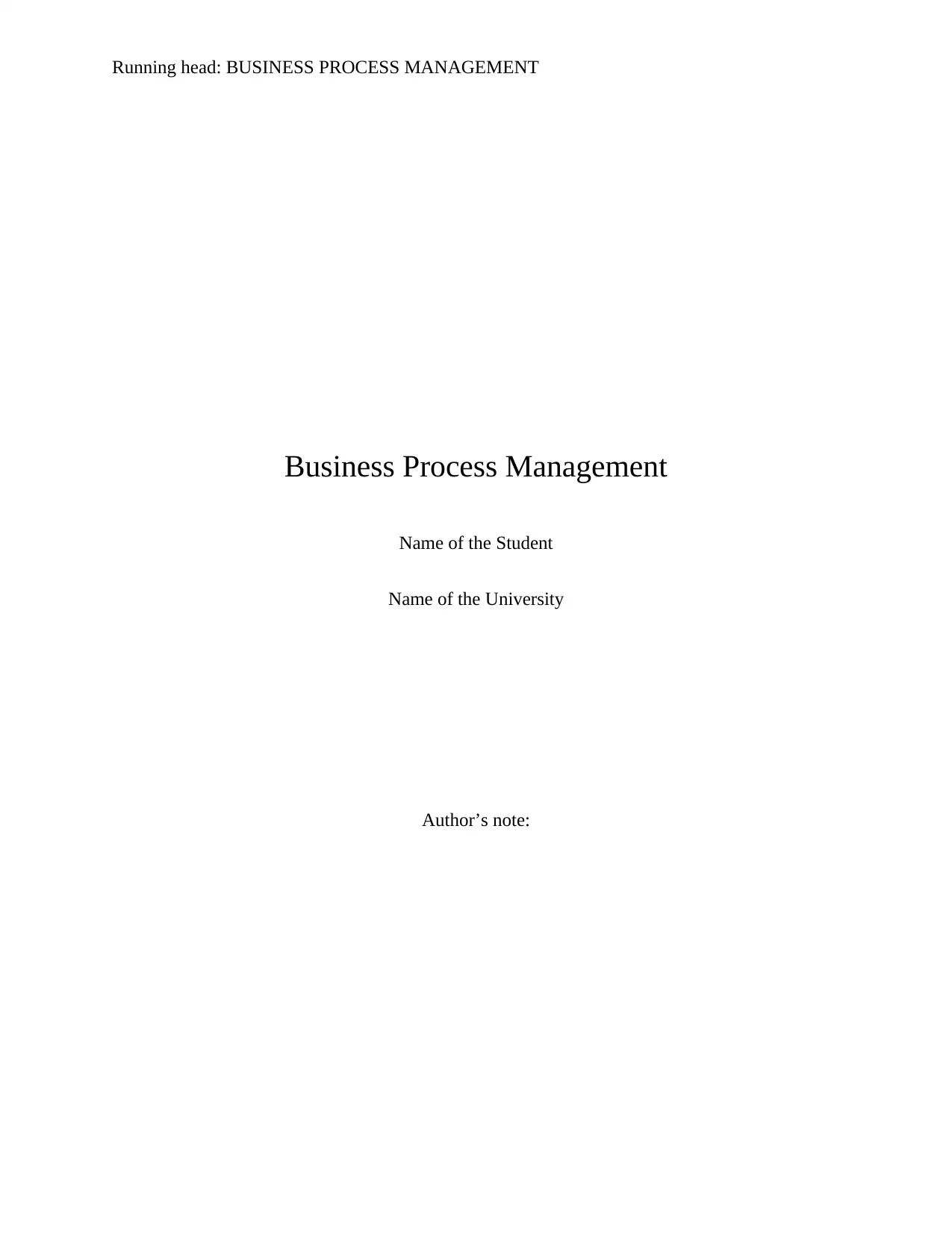
Running head: BUSINESS PROCESS MANAGEMENT
Business Process Management
Name of the Student
Name of the University
Author’s note:
Business Process Management
Name of the Student
Name of the University
Author’s note:
Paraphrase This Document
Need a fresh take? Get an instant paraphrase of this document with our AI Paraphraser
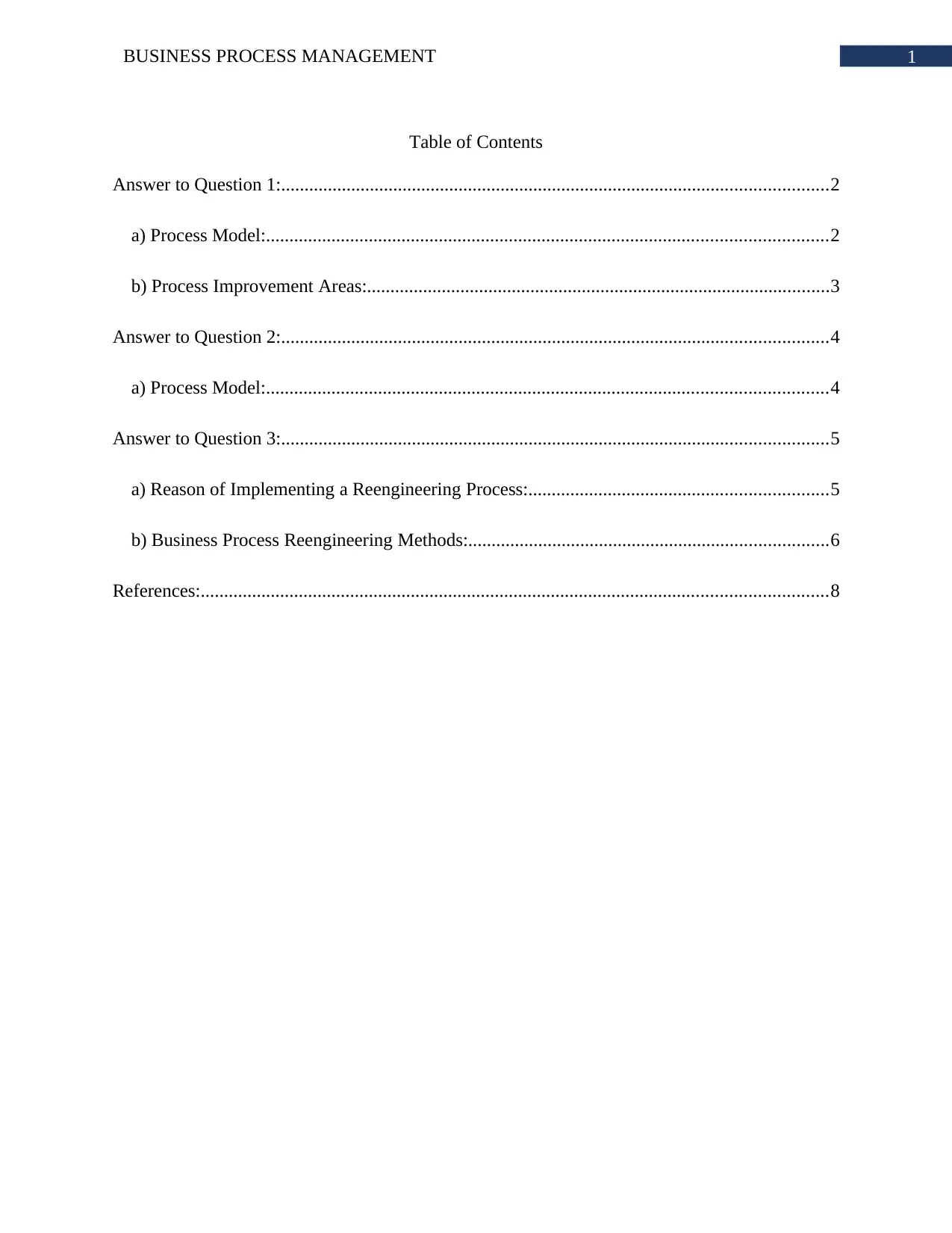
1BUSINESS PROCESS MANAGEMENT
Table of Contents
Answer to Question 1:.....................................................................................................................2
a) Process Model:........................................................................................................................2
b) Process Improvement Areas:...................................................................................................3
Answer to Question 2:.....................................................................................................................4
a) Process Model:........................................................................................................................4
Answer to Question 3:.....................................................................................................................5
a) Reason of Implementing a Reengineering Process:................................................................5
b) Business Process Reengineering Methods:.............................................................................6
References:......................................................................................................................................8
Table of Contents
Answer to Question 1:.....................................................................................................................2
a) Process Model:........................................................................................................................2
b) Process Improvement Areas:...................................................................................................3
Answer to Question 2:.....................................................................................................................4
a) Process Model:........................................................................................................................4
Answer to Question 3:.....................................................................................................................5
a) Reason of Implementing a Reengineering Process:................................................................5
b) Business Process Reengineering Methods:.............................................................................6
References:......................................................................................................................................8
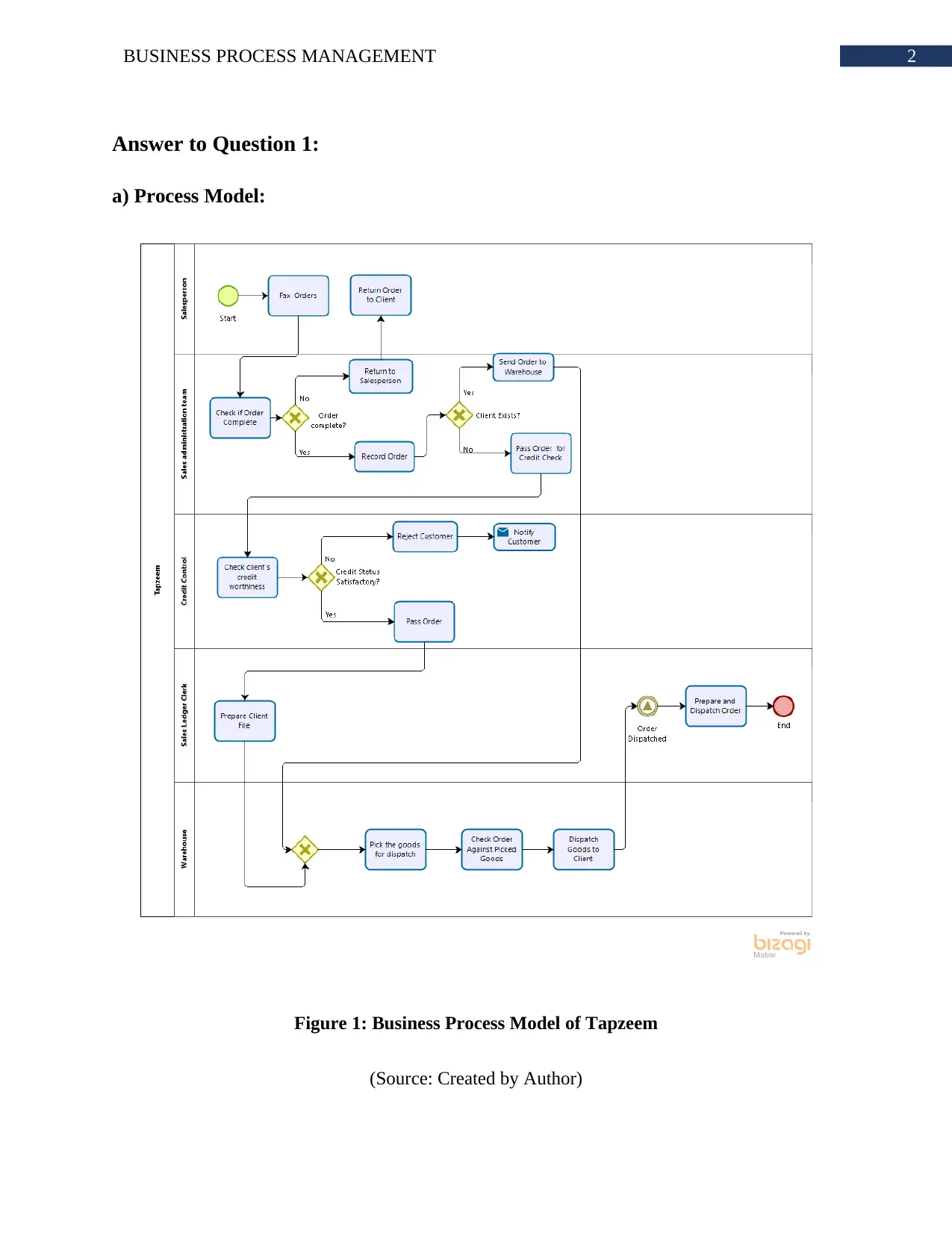
2BUSINESS PROCESS MANAGEMENT
Answer to Question 1:
a) Process Model:
Figure 1: Business Process Model of Tapzeem
(Source: Created by Author)
Answer to Question 1:
a) Process Model:
Figure 1: Business Process Model of Tapzeem
(Source: Created by Author)
⊘ This is a preview!⊘
Do you want full access?
Subscribe today to unlock all pages.

Trusted by 1+ million students worldwide

3BUSINESS PROCESS MANAGEMENT
b) Process Improvement Areas:
First Improvement: The sales person is responsible for faxing the orders to the sales
administration team. For faxing the order, the salesperson needs time and the order remains in
the queue for some time. It is assumed that thirty percent of the orders are not complete. Then the
sales administration team return the order and sales team communicate with the customer. The
whole process is very time consuming and includes a lot of waiting time. This can be resolved by
creating an application for the customers. The customers will place their orders through that
application. The application will be designed such a way that it will only accept an order when it
is complete.
Second Improvement: The organization does not have a proper communication medium.
All the works are done via fax, email or papers. The organization needs a communication
medium that can connect all the departments in a central location. This improvement will hugely
impact the productivity of the organization. The departments can easily share data in structured
manner. All the departments can be communicated easily in the need. The salesperson will just
check basic things and click on a button to active the order and sales administration team will get
a notification.
Third Improvement: None of department has same details. That means that if one
department has one information that may not be similar to data available in other department. If
an order has been sent for completing, the salesperson cannot know that until the response from
sales administrative team reaches. A database management system can be the solution to this
issues. The organization can implement a centralized database that can be used for storing the
details of activities and customer orders. This will have huge impact in the organization process
b) Process Improvement Areas:
First Improvement: The sales person is responsible for faxing the orders to the sales
administration team. For faxing the order, the salesperson needs time and the order remains in
the queue for some time. It is assumed that thirty percent of the orders are not complete. Then the
sales administration team return the order and sales team communicate with the customer. The
whole process is very time consuming and includes a lot of waiting time. This can be resolved by
creating an application for the customers. The customers will place their orders through that
application. The application will be designed such a way that it will only accept an order when it
is complete.
Second Improvement: The organization does not have a proper communication medium.
All the works are done via fax, email or papers. The organization needs a communication
medium that can connect all the departments in a central location. This improvement will hugely
impact the productivity of the organization. The departments can easily share data in structured
manner. All the departments can be communicated easily in the need. The salesperson will just
check basic things and click on a button to active the order and sales administration team will get
a notification.
Third Improvement: None of department has same details. That means that if one
department has one information that may not be similar to data available in other department. If
an order has been sent for completing, the salesperson cannot know that until the response from
sales administrative team reaches. A database management system can be the solution to this
issues. The organization can implement a centralized database that can be used for storing the
details of activities and customer orders. This will have huge impact in the organization process
Paraphrase This Document
Need a fresh take? Get an instant paraphrase of this document with our AI Paraphraser
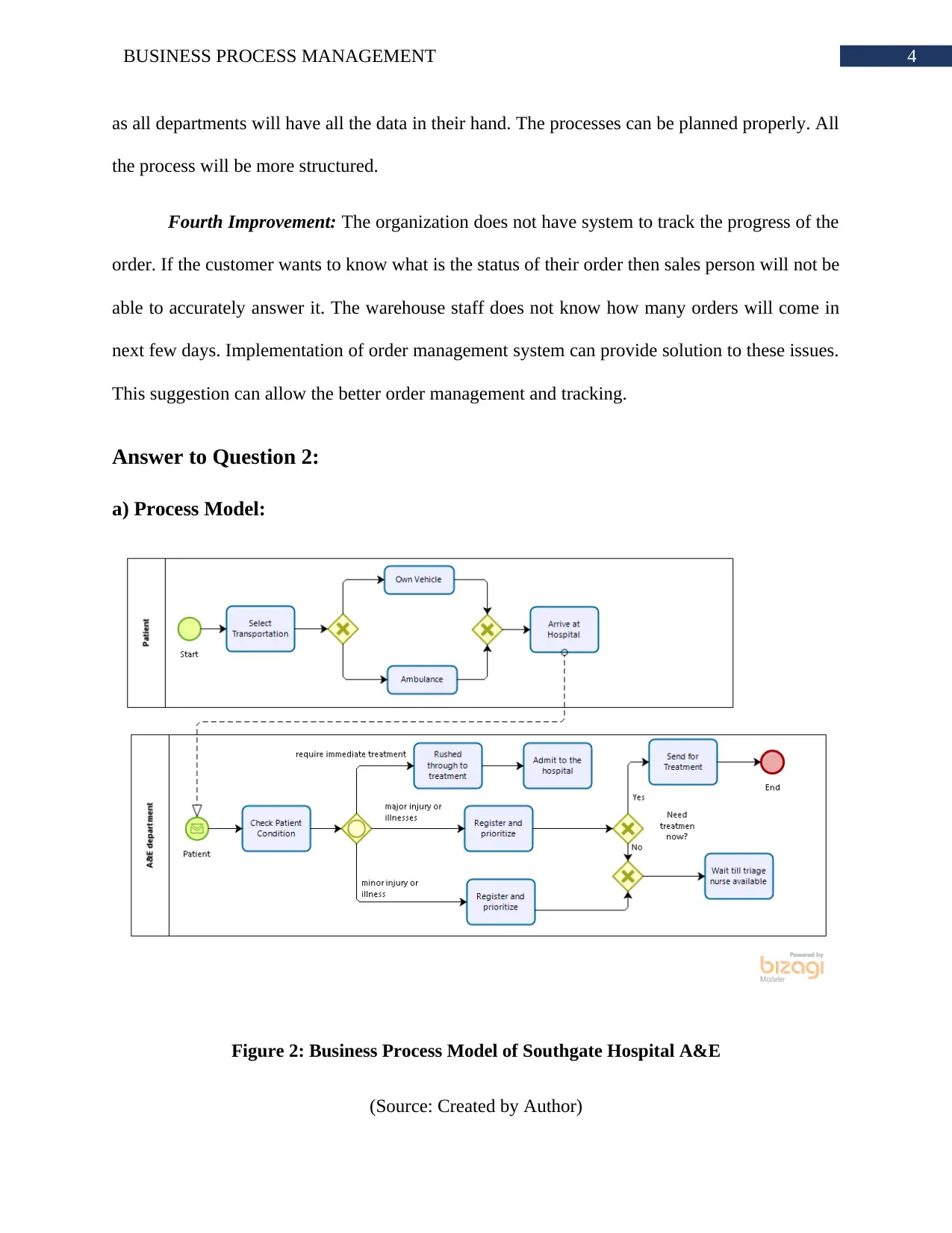
4BUSINESS PROCESS MANAGEMENT
as all departments will have all the data in their hand. The processes can be planned properly. All
the process will be more structured.
Fourth Improvement: The organization does not have system to track the progress of the
order. If the customer wants to know what is the status of their order then sales person will not be
able to accurately answer it. The warehouse staff does not know how many orders will come in
next few days. Implementation of order management system can provide solution to these issues.
This suggestion can allow the better order management and tracking.
Answer to Question 2:
a) Process Model:
Figure 2: Business Process Model of Southgate Hospital A&E
(Source: Created by Author)
as all departments will have all the data in their hand. The processes can be planned properly. All
the process will be more structured.
Fourth Improvement: The organization does not have system to track the progress of the
order. If the customer wants to know what is the status of their order then sales person will not be
able to accurately answer it. The warehouse staff does not know how many orders will come in
next few days. Implementation of order management system can provide solution to these issues.
This suggestion can allow the better order management and tracking.
Answer to Question 2:
a) Process Model:
Figure 2: Business Process Model of Southgate Hospital A&E
(Source: Created by Author)

5BUSINESS PROCESS MANAGEMENT
Answer to Question 3:
a) Reason of Implementing a Reengineering Process:
The first reason is the clarity of purpose. In order to implement a business process
reengineering, the organization must have complete idea of all the business parts and its current
processes. Having a proper idea of how a business process works means that organization knows
all the inputs and outputs of a process. There are always a possibility of finding faulty
assumptions or information in the business structure (Park et al., 2017). The market is every
changing so as the customers. In order to cope with the changing industry patterns, the business
process reengineering must be implemented.
Simple and streamlined operation is the second reason for implementing business process
reengineering. The business process reengineering eliminates the process that adds a lot of
waiting time or are not good for business (Grant, 2016). The business process reengineering also
streamlines the functions of the business. The staffs will have a well-defined short path to
complete their work. The production of the organization staff will increase hugely.
Increased efficiency: The streamlined operations brings efficiency in the business
processes. The organization can make the business more robust by combining the tweaking
processes and business operations. The overall efficiency of the business are increased greatly by
this decision (Pattanayak & Roy, 2015). The staff will get more time to concentrate on their
primary work rather than waiting for other tasks to be completed first.
Better Results and Products: The focused gaols and efficiency allow the organization to
be more efficient and effective in terms of productivity. The improvement of the organization are
supported by the better lines of communication and organization policies. The innovation in the
Answer to Question 3:
a) Reason of Implementing a Reengineering Process:
The first reason is the clarity of purpose. In order to implement a business process
reengineering, the organization must have complete idea of all the business parts and its current
processes. Having a proper idea of how a business process works means that organization knows
all the inputs and outputs of a process. There are always a possibility of finding faulty
assumptions or information in the business structure (Park et al., 2017). The market is every
changing so as the customers. In order to cope with the changing industry patterns, the business
process reengineering must be implemented.
Simple and streamlined operation is the second reason for implementing business process
reengineering. The business process reengineering eliminates the process that adds a lot of
waiting time or are not good for business (Grant, 2016). The business process reengineering also
streamlines the functions of the business. The staffs will have a well-defined short path to
complete their work. The production of the organization staff will increase hugely.
Increased efficiency: The streamlined operations brings efficiency in the business
processes. The organization can make the business more robust by combining the tweaking
processes and business operations. The overall efficiency of the business are increased greatly by
this decision (Pattanayak & Roy, 2015). The staff will get more time to concentrate on their
primary work rather than waiting for other tasks to be completed first.
Better Results and Products: The focused gaols and efficiency allow the organization to
be more efficient and effective in terms of productivity. The improvement of the organization are
supported by the better lines of communication and organization policies. The innovation in the
⊘ This is a preview!⊘
Do you want full access?
Subscribe today to unlock all pages.

Trusted by 1+ million students worldwide
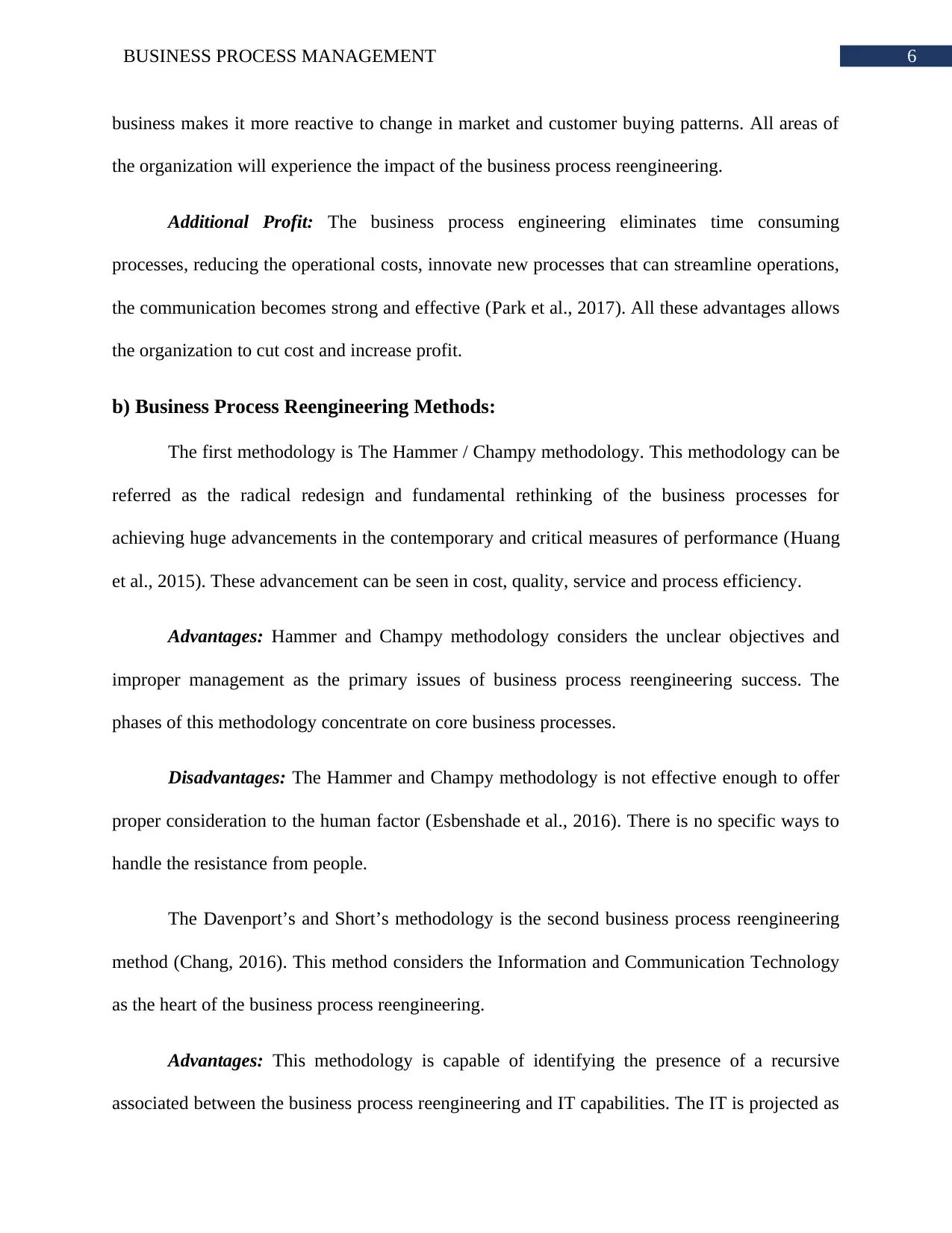
6BUSINESS PROCESS MANAGEMENT
business makes it more reactive to change in market and customer buying patterns. All areas of
the organization will experience the impact of the business process reengineering.
Additional Profit: The business process engineering eliminates time consuming
processes, reducing the operational costs, innovate new processes that can streamline operations,
the communication becomes strong and effective (Park et al., 2017). All these advantages allows
the organization to cut cost and increase profit.
b) Business Process Reengineering Methods:
The first methodology is The Hammer / Champy methodology. This methodology can be
referred as the radical redesign and fundamental rethinking of the business processes for
achieving huge advancements in the contemporary and critical measures of performance (Huang
et al., 2015). These advancement can be seen in cost, quality, service and process efficiency.
Advantages: Hammer and Champy methodology considers the unclear objectives and
improper management as the primary issues of business process reengineering success. The
phases of this methodology concentrate on core business processes.
Disadvantages: The Hammer and Champy methodology is not effective enough to offer
proper consideration to the human factor (Esbenshade et al., 2016). There is no specific ways to
handle the resistance from people.
The Davenport’s and Short’s methodology is the second business process reengineering
method (Chang, 2016). This method considers the Information and Communication Technology
as the heart of the business process reengineering.
Advantages: This methodology is capable of identifying the presence of a recursive
associated between the business process reengineering and IT capabilities. The IT is projected as
business makes it more reactive to change in market and customer buying patterns. All areas of
the organization will experience the impact of the business process reengineering.
Additional Profit: The business process engineering eliminates time consuming
processes, reducing the operational costs, innovate new processes that can streamline operations,
the communication becomes strong and effective (Park et al., 2017). All these advantages allows
the organization to cut cost and increase profit.
b) Business Process Reengineering Methods:
The first methodology is The Hammer / Champy methodology. This methodology can be
referred as the radical redesign and fundamental rethinking of the business processes for
achieving huge advancements in the contemporary and critical measures of performance (Huang
et al., 2015). These advancement can be seen in cost, quality, service and process efficiency.
Advantages: Hammer and Champy methodology considers the unclear objectives and
improper management as the primary issues of business process reengineering success. The
phases of this methodology concentrate on core business processes.
Disadvantages: The Hammer and Champy methodology is not effective enough to offer
proper consideration to the human factor (Esbenshade et al., 2016). There is no specific ways to
handle the resistance from people.
The Davenport’s and Short’s methodology is the second business process reengineering
method (Chang, 2016). This method considers the Information and Communication Technology
as the heart of the business process reengineering.
Advantages: This methodology is capable of identifying the presence of a recursive
associated between the business process reengineering and IT capabilities. The IT is projected as
Paraphrase This Document
Need a fresh take? Get an instant paraphrase of this document with our AI Paraphraser
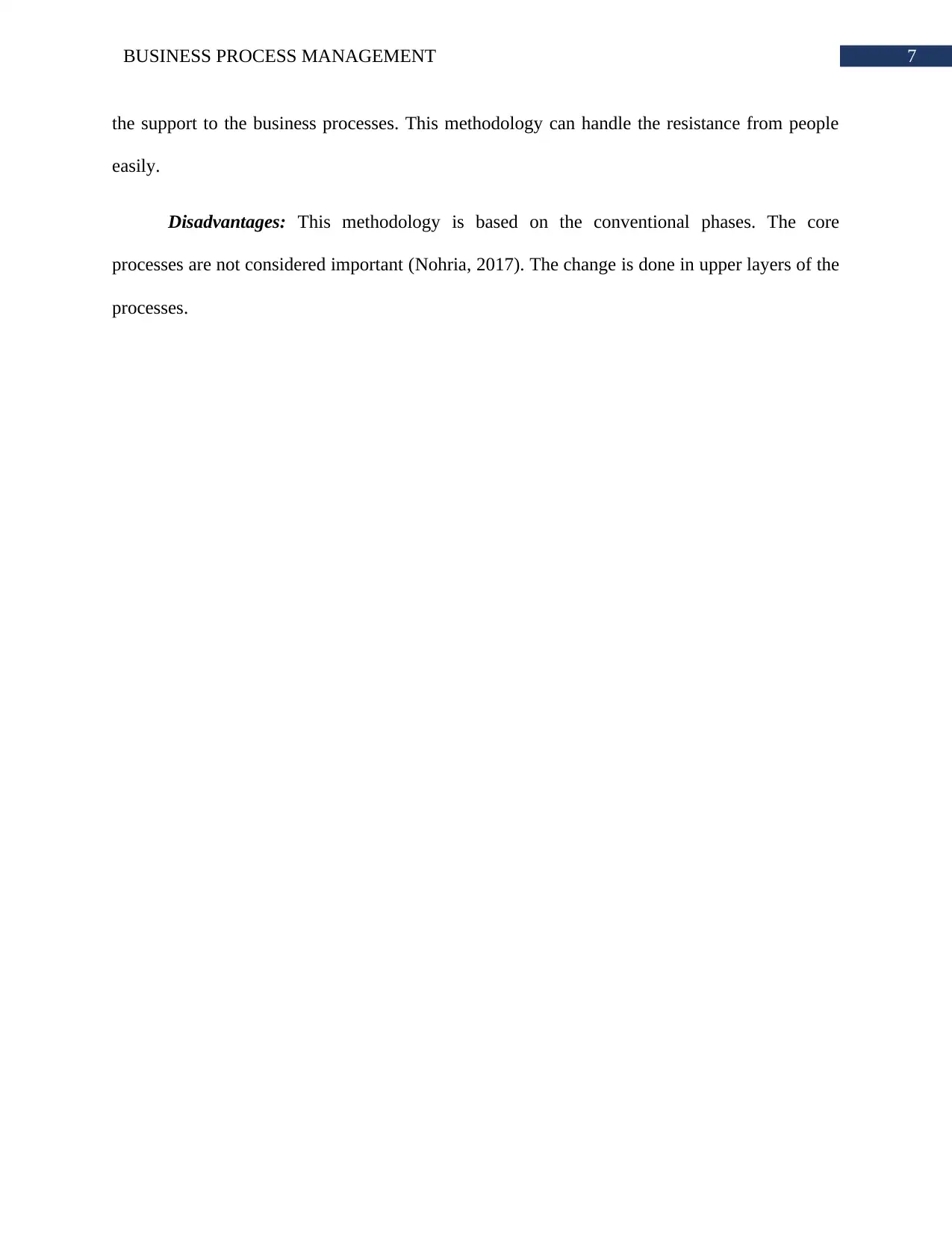
7BUSINESS PROCESS MANAGEMENT
the support to the business processes. This methodology can handle the resistance from people
easily.
Disadvantages: This methodology is based on the conventional phases. The core
processes are not considered important (Nohria, 2017). The change is done in upper layers of the
processes.
the support to the business processes. This methodology can handle the resistance from people
easily.
Disadvantages: This methodology is based on the conventional phases. The core
processes are not considered important (Nohria, 2017). The change is done in upper layers of the
processes.
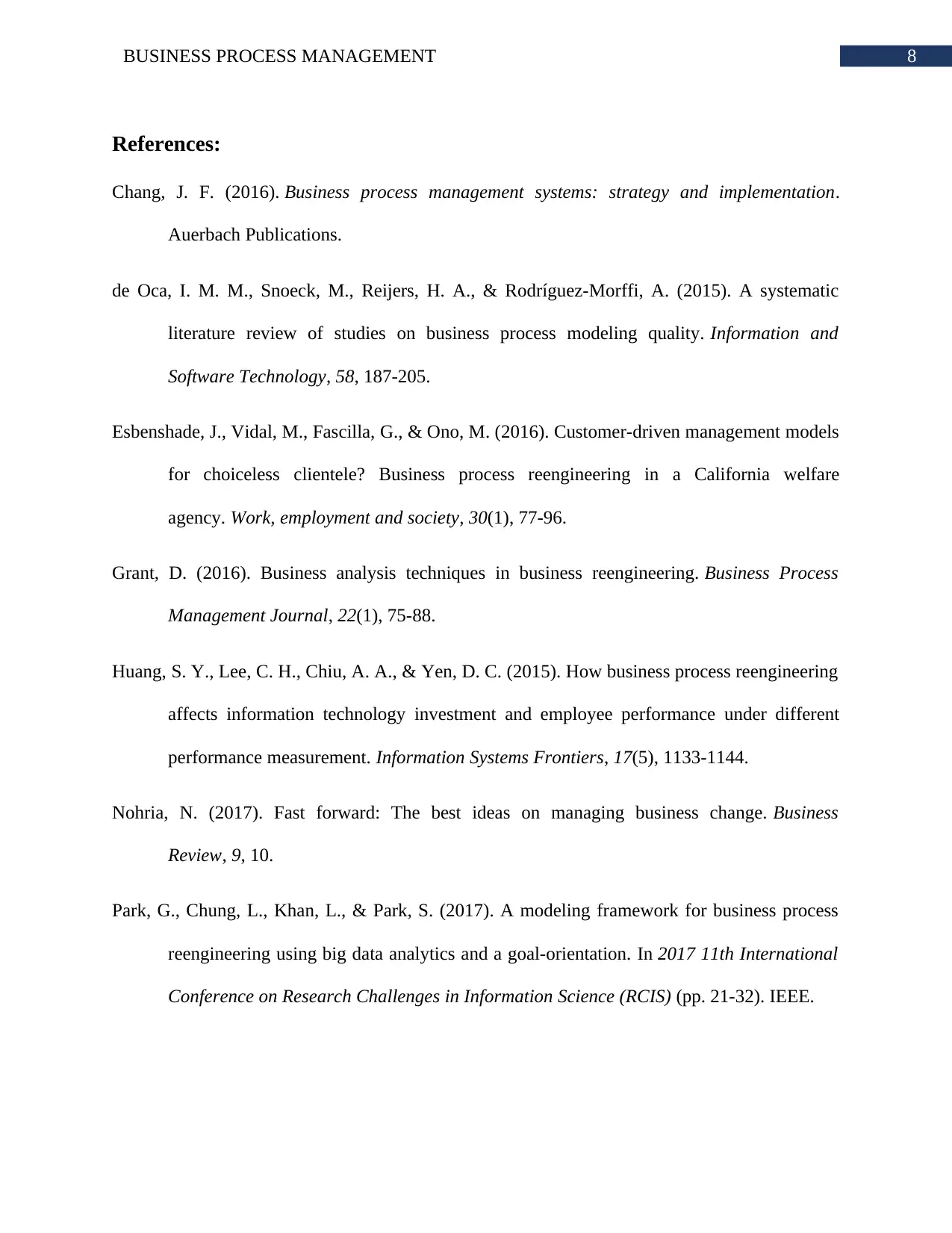
8BUSINESS PROCESS MANAGEMENT
References:
Chang, J. F. (2016). Business process management systems: strategy and implementation.
Auerbach Publications.
de Oca, I. M. M., Snoeck, M., Reijers, H. A., & Rodríguez-Morffi, A. (2015). A systematic
literature review of studies on business process modeling quality. Information and
Software Technology, 58, 187-205.
Esbenshade, J., Vidal, M., Fascilla, G., & Ono, M. (2016). Customer-driven management models
for choiceless clientele? Business process reengineering in a California welfare
agency. Work, employment and society, 30(1), 77-96.
Grant, D. (2016). Business analysis techniques in business reengineering. Business Process
Management Journal, 22(1), 75-88.
Huang, S. Y., Lee, C. H., Chiu, A. A., & Yen, D. C. (2015). How business process reengineering
affects information technology investment and employee performance under different
performance measurement. Information Systems Frontiers, 17(5), 1133-1144.
Nohria, N. (2017). Fast forward: The best ideas on managing business change. Business
Review, 9, 10.
Park, G., Chung, L., Khan, L., & Park, S. (2017). A modeling framework for business process
reengineering using big data analytics and a goal-orientation. In 2017 11th International
Conference on Research Challenges in Information Science (RCIS) (pp. 21-32). IEEE.
References:
Chang, J. F. (2016). Business process management systems: strategy and implementation.
Auerbach Publications.
de Oca, I. M. M., Snoeck, M., Reijers, H. A., & Rodríguez-Morffi, A. (2015). A systematic
literature review of studies on business process modeling quality. Information and
Software Technology, 58, 187-205.
Esbenshade, J., Vidal, M., Fascilla, G., & Ono, M. (2016). Customer-driven management models
for choiceless clientele? Business process reengineering in a California welfare
agency. Work, employment and society, 30(1), 77-96.
Grant, D. (2016). Business analysis techniques in business reengineering. Business Process
Management Journal, 22(1), 75-88.
Huang, S. Y., Lee, C. H., Chiu, A. A., & Yen, D. C. (2015). How business process reengineering
affects information technology investment and employee performance under different
performance measurement. Information Systems Frontiers, 17(5), 1133-1144.
Nohria, N. (2017). Fast forward: The best ideas on managing business change. Business
Review, 9, 10.
Park, G., Chung, L., Khan, L., & Park, S. (2017). A modeling framework for business process
reengineering using big data analytics and a goal-orientation. In 2017 11th International
Conference on Research Challenges in Information Science (RCIS) (pp. 21-32). IEEE.
⊘ This is a preview!⊘
Do you want full access?
Subscribe today to unlock all pages.

Trusted by 1+ million students worldwide

9BUSINESS PROCESS MANAGEMENT
Pattanayak, S., & Roy, S. (2015). Synergizing business process reengineering with enterprise
resource planning system in capital goods industry. Procedia-Social and Behavioral
Sciences, 189, 471-487.
Rosa, M. L., Van Der Aalst, W. M., Dumas, M., & Milani, F. P. (2017). Business process
variability modeling: A survey. ACM Computing Surveys (CSUR), 50(1), 2.
Pattanayak, S., & Roy, S. (2015). Synergizing business process reengineering with enterprise
resource planning system in capital goods industry. Procedia-Social and Behavioral
Sciences, 189, 471-487.
Rosa, M. L., Van Der Aalst, W. M., Dumas, M., & Milani, F. P. (2017). Business process
variability modeling: A survey. ACM Computing Surveys (CSUR), 50(1), 2.
1 out of 10
Related Documents
Your All-in-One AI-Powered Toolkit for Academic Success.
+13062052269
info@desklib.com
Available 24*7 on WhatsApp / Email
![[object Object]](/_next/static/media/star-bottom.7253800d.svg)
Unlock your academic potential
Copyright © 2020–2025 A2Z Services. All Rights Reserved. Developed and managed by ZUCOL.





